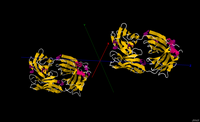
Photo from wikipedia
Uridine diphosphate glucuronosyltransferase 1A1 (UGT1A1) polymorphism plays a crucial role in the increased susceptibility and toxicity of patients to irinotecan. This retrospective, observational study compared the clinical outcomes and adverse… Click to show full abstract
Uridine diphosphate glucuronosyltransferase 1A1 (UGT1A1) polymorphism plays a crucial role in the increased susceptibility and toxicity of patients to irinotecan. This retrospective, observational study compared the clinical outcomes and adverse events (AEs) in RAS wild-type metastatic colorectal cancer (mCRC) patients treated with cetuximab or bevacizumab plus FOLFIRI with UGT1A1 genotyping and irinotecan dose escalation as the first-line therapy. In total, 173 patients with mCRC with RAS wild-type were enrolled. Among them, 98 patients were treated with cetuximab, whereas 75 patients were treated with bevacizumab. All patients received irinotecan dose escalation based on UGT1A1 genotyping. We compared the progression-free survival (PFS), overall survival (OS), objective response rates (ORRs), disease control rates (DCRs), metastatectomy, and severe adverse events (SAEs) between the two groups. The clinical effects of primary tumor sidedness and target therapy crossover were further analyzed. Over a median follow-up of 23.0 months [interquartile range (IQR), 15.0–32.5 months], no significant differences were observed between the cetuximab and bevacizumab groups in PFS [18.0 months vs. 14.0 months; 95% confidence interval (CI), 0.517–1.027; hazard ratio (HR), 0.729; p = 0.071], OS (40.0 months vs. 30.0 months; 95% CI, 0.410–1.008; HR, 0.643; p = 0.054), ORR (65.3% vs. 62.7%; p = 0.720), DCR (92.8% vs. 86.7%; p = 0.175), metastatectomy (36.7% vs. 29.3%; p = 0.307), and SAEs (p = 0.685). Regardless of primary tumor sidedness and target therapy crossover, no significant differences were noted in efficacy and safety between the two groups (all p > 0.05). Our results revealed that patients with wild-type RAS mCRC, regardless of biologics, with UGT1A1 genotyping can tolerate escalated doses of irinotecan and potentially achieve a more favorable clinical outcome without significantly increased toxicity.
Journal Title: Oncology Research
Year Published: 2022
Link to full text (if available)
Share on Social Media: Sign Up to like & get
recommendations!